Are you looking for the perfect Yellowstone three-day itinerary? This guide will help you to see the most Instagram-worthy Yellowstone sights while still getting out into nature on a gorgeous scenic hike each day!
Yellowstone National Park is a stunning, popular national park located in the western states of the United States. Most of the park is located largely in the northwest corner of Wyoming and the park also extends into parts of Montana and Idaho.
As America’s oldest and perhaps most unique park, Yellowstone National Park has been mesmerizing millions of visitors each year. They flock to the park to see its famous hot springs, plenty of roaming wildlife, and hundreds of sparkling geysers such as the legendary Old Faithful. Yellowstone is a haven of geothermal wonders, rocky canyons, and dense forests, sprawling across 3500 square miles, and it’s a bucket list MUST for any visitor to this area of the USA.
This article shares my best tips for visiting Yellowstone, essential directions for planning your trip, and my suggested Yellowstone 3-day itinerary. Enjoy!

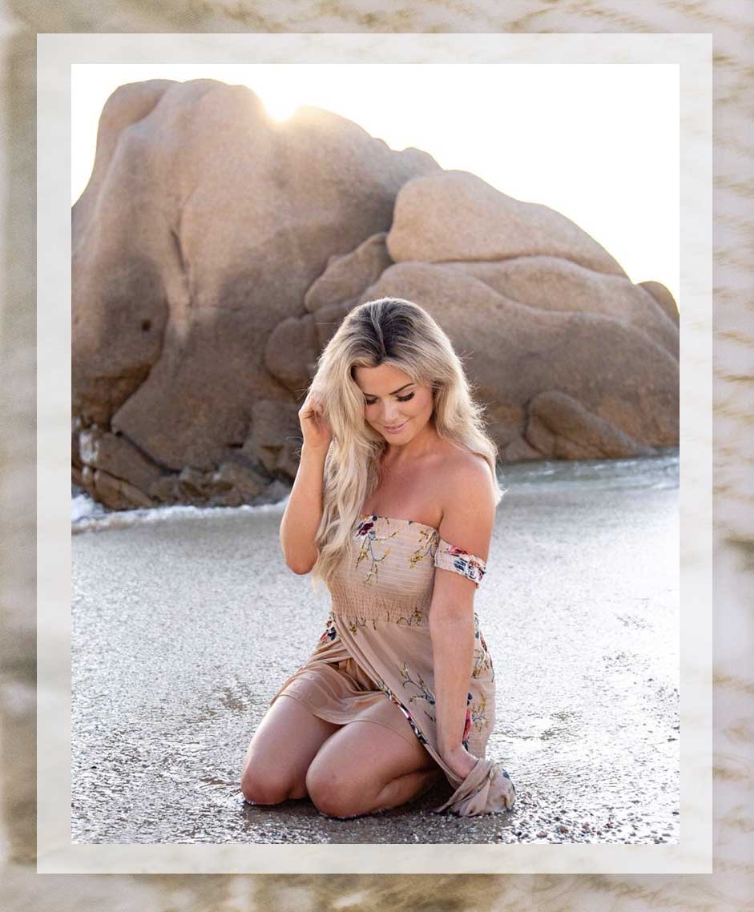
Stay in Touch
EMAIL NEWSLETTER
Be the first to find out about new blogs, course offerings, travel guides, giveaways and freebies. I will always respect your privacy – unsubscribe anytime.
![]()
When is the best time to Visit Yellowstone?
In my opinion, the best months to visit Yellowstone are the shoulder season months, from late April to May and September through early October. These off-season months offer fewer crowds, mild weather, and little to no road blockages as all of the sights are still open to see – but with much fewer crowds!
In the summertime, the best months to visit Yellowstone Park are July and August, when the weather is mild and warm enough to sleep outside if you’re hoping to camp in Yellowstone. This is a great time for families to visit the park, as children are out of school for summer holidays.
However, Yellowstone is no stranger to the cold, and the temperature will drop substantially in the autumn and winter months. There is no bad time to visit the park though, as it looks magical under autumn and winter conditions, too. There is nothing more mesmerizing than seeing plumes of steam rising from a thick blanket of snow and ice amongst the famous Yellowstone scenery.
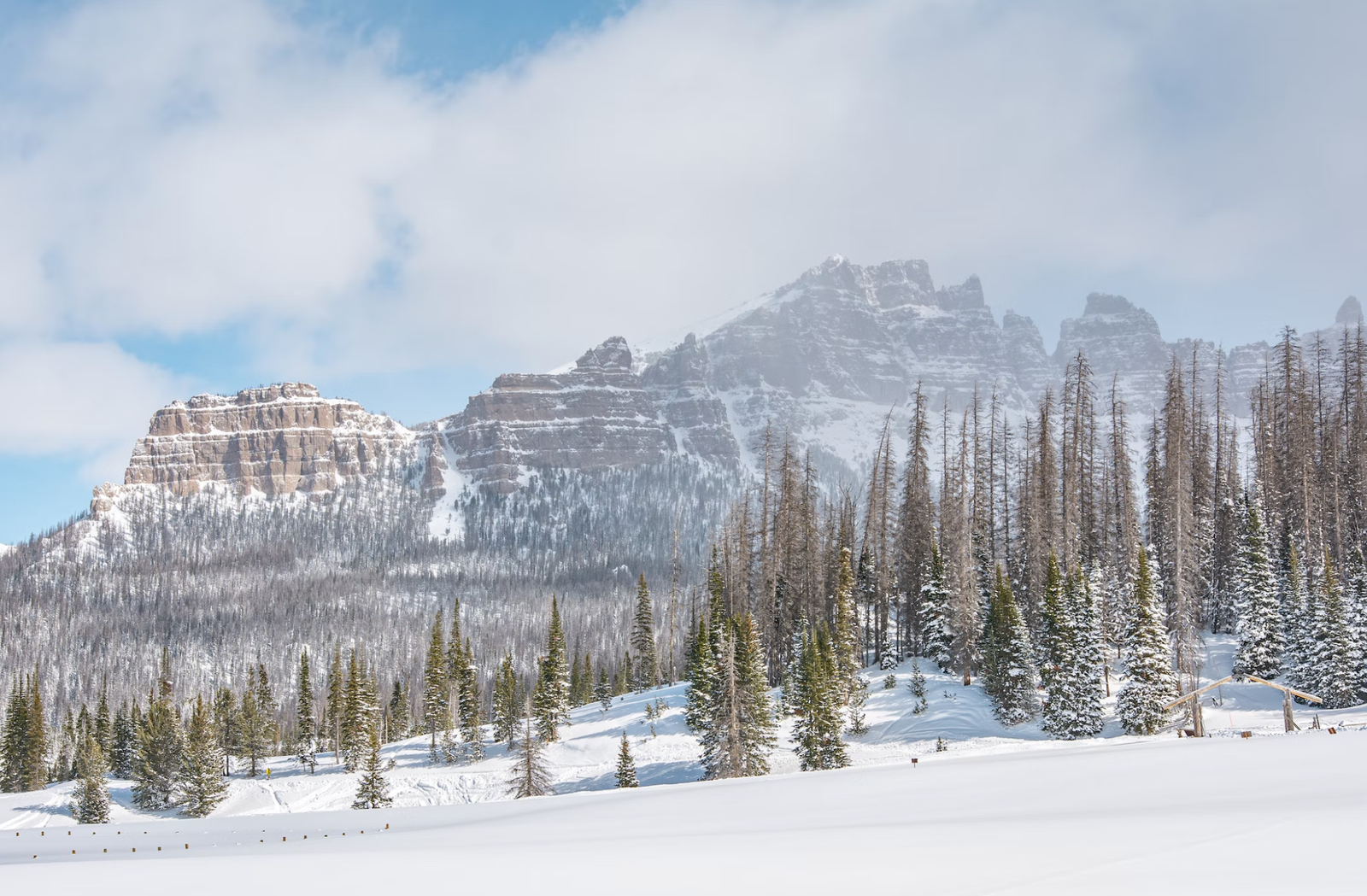
However, the best time for YOUR visit should depend upon what you want to do and see in the park. Don’t let the weather stop you from visiting Yellowstone, but you’ll want to make sure your bucket list items are open during the season you plan to visit.
The seasons in Yellowstone are as follows:
Spring: April – May
Spring weather in Yellowstone may be erratic, but you can avoid crowds if your timing is right! This season is quite an active time for local wildlife and provides a great opportunity for spotting grizzly bears, elk, wolves, moose, and other animals emerging from their winter hibernation. Plan to bring many layers, as the average temperature can change from the low 60s to single digits.
Due to seasonal road closures, visiting Yellowstone near the end of April and May is preferable. Usually, roads begin to open between the middle of April and the end of May. Visit the National Park Service website to discover the most recent road closures and opening dates.
![]()
Summer: June-August
Summer is a great time to visit Yellowstone if you want to experience everything the park offers while enjoying the warmest weather it receives.
During the summer, Yellowstone experiences a wide range of temperatures, with daytime temperatures around 70°F (21°C) and even sometimes as warm as 80°F (27°C) at lower elevation areas of the park, making for very pleasant and ideal hiking conditions. Nighttime temperatures are usually cool and may drop below freezing at higher elevation areas of the park. Additionally, all the park’s facilities will be available in summer, so you can check off everything on your Yellowstone bucket list!
For festival lovers, July is a special time to visit Yellowstone as it hosts various events. Despite the crowds and higher prices, mid-June to mid-September is an excellent time of the year to visit Yellowstone National Park.
Something to keep in mind is that summer is also the busiest season of the year in Yellowstone, and the park welcomes more than 2 million tourists, indicating that accommodations will be booked up quickly. It’s also one of the most expensive times to visit Yellowstone.
If you are planning for a Yellowstone three-day itinerary during the busiest season, book your accommodations as soon as you can!
Save on hotels in Yellowstone with my Expedia discount link:
Autumn: September-October
Autumn is also an amazing season to visit Yellowstone because the weather is still moderate, and the fall colors are stunning here. There are also a lot of opportunities for wildlife watching, and almost all of the summer tourists have left, leaving behind plenty of reasonably-priced hotel rooms.
During the daytime, the average temperature ranges from the mid-30s to the low 60s F. However, the nighttime temperature may range between teens and single digits F, something to keep in mind if you’re planning on camping.
Be aware that many amenities, including general stores, visitor centers, post offices, etc. may close as early as mid-September. Additionally, seasonal roadblocks begin in mid-October, so remember to check the National Park Service website for recent road closure information.
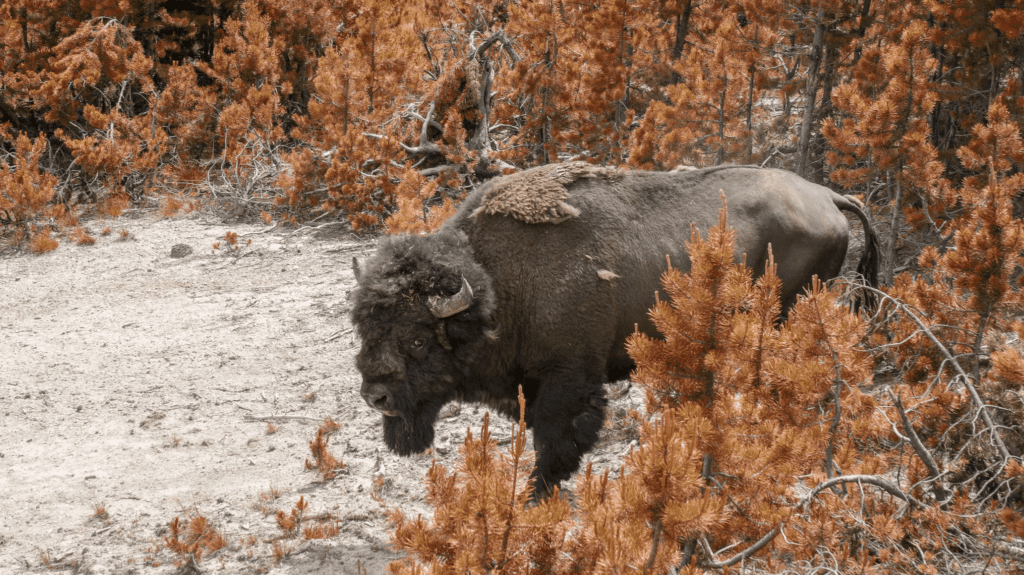
![]()
Winter: November-March
Yellowstone’s winter season is not for the timid! Yellowstone experiences heavy snowfall during this season, and daytime temperatures are rarely above freezing.
If you plan a Yellowstone three-day itinerary during this time of year, you should be prepared for hazardous driving conditions, as some roads will be closed. Always have winter safety equipment on hand, like maps, snow tires, warm sleeping bags, booster cables, flashlights, shovels, first aid kits, and extra food and water.
In the winter, only the North Entrance is accessible by car. By December, all Yellowstone park facilities—aside from the Yellowstone visitor center in the Mammoth Hot Springs region—will be closed for the year. However, if you’ve already seen the sights and just want to visit the scenery that’s accesible in the winter, it’s a quiet time to visit without crowds, so this might be the perfect time for you! Just remember to bundle up and bring lots of layers.
You’re not going to want to camp in the winter, so make sure to find your Yellowstone accomodation before you depart!

![]()
How Do You Get to Yellowstone?
The first step in planning a tour of Yellowstone National Park is to decide how to get there.
Yellowstone National park is huge, covering 2.2 million acres, an area greater than Rhode Island! Yellowstone provides a fantastic road trip destination due to its location and several entrances to choose from, depending where you’re coming from and what you wish to see. It’s a good idea to plan your 3-day Yellowstone itinerary ahead of time and know which entrance is closest to the sights on your bucket list. The North Entrance, Northeast Entrance, East Entrance, South Entrance, and West Entrance are the five entrances to Yellowstone.
Best way to get to Yellowstone: Flying to Yellowstone National Park
Flying to Yellowstone and renting a car is the easiest and best way to get to Yellowstone National Park if you’re coming from further away. Although Yellowstone’s location is a little remote, there are several regional airports close by. All airports offer rental car service, making easy and time-efficient access to Yellowstone possible.
Airports Near Yellowstone National Park
Yellowstone Airport
Yellowstone Airport (WYS) is a seasonal airport located one mile away from the center of West Yellowstone, Montana. The airport is open during summer (from June to September). SkyWest Airlines and Delta Airlines operate flights from Sky Lake Park.
Distance from West Entrance: 3 miles
Drive time from West Entrance: 7 minutes
Yellowstone Regional Airport
Yellowstone Regional Airport (COD) is situated in Cody, Wyoming, on the western side of Yellowstone. It is the closest airport to Yellowstone, and the only year-round airport. However, the park’s east entrances are shut throughout the winter. Therefore, the park is only accessible from this airport from late spring through mid-fall. Daily flights are available from the regional hubs of United and Delta.
Distance from East Entrance: 55 miles
Drive time from East Entrance: 1 hour
Jackson Hole Airport
Jackson Hole Airport (JAC) is an open year-round airport near Jackson, Wyoming. It is the only airport located in Yellowstone National Park. American Airlines, Delta, and United offer services to the airport. During summer, flights land from all over the United States. However, flights from Denver, Salt Lake City, and Dallas/Fort Worth arrive during the rest of the year.
Distance from South Entrance: 70 miles
Drive time from South Entrance: 1 hour
Salt Lake City International Airport
Salt Lake City International Airport (SLC) is also an open year-round airport located in Salt Lake City, Utah. The airport is the fourth-largest hub for Delta Airlines. American Airlines, Alaska Airlines, JetBlue, Frontier, KLM, United, and Southwest all offer flights to Salt Lake City.
Distance from West Entrance: 323 miles
Drive time from West Entrance: 5 hours
Bozeman Yellowstone International Airport
Bozeman Yellowstone International Airport (BZN) is situated near Bozeman, Montana. It is the busiest airport in Montana and is open throughout the year. American Airlines, Delta. Allegiant, Alaska Airlines, United, and Frontier, all offer flights to and from the airport. JetBlue provides summertime flights. Many parts of the United States provide direct flights all year round.
Distance from North Entrance: 91 miles
Drive time from North Entrance: 5 hours
 Driving to Yellowstone National Park
Driving to Yellowstone National Park
Yellowstone National Park is situated somewhat off-center in a square surrounded by Interstates I-90, I-25, I-80, and I-15, but the park’s boundary is not especially close to any interstates. Even though I-15 and I-90 are close enough, it’ll still take you about an hour to reach any of the Yellowstone entrances.
Visiting Yellowstone National Park with a car is the best option (and perhaps, the only option, as you’ll learn below).
There are five entrances to Yellowstone National Park you can choose from:
- North Entrance brings you to Gardiner, Montana, through Highway 89 – best for visiting Mammoth Hot Springs
- Northeast Entrance brings you to Cooke City, Montana, through Highway 212– best for visiting Lamar Valley
- South Entrance brings you to Jackson, Wyoming, through Highway 191–best for those visiting Grand Teton National Park
- East Entrance brings you to Cody, Wyoming, through Highway 20– best for visiting Yellowstone Lake
- West Entrance brings you to West Yellowstone, Montana, through Highway 20 and 191
Only the North entrance is available all year round during the winter. You can enter the Mammoth Hot Springs region by car. All other entrances to Yellowstone are closed to vehicle traffic and will open in spring. West Entrances and South Entrances are closed to vehicle traffic during winter but open for guided snow coach or snowmobile tours. The South and East Entrances are open for guided snowmobile tours.

Public Transport to Yellowstone
There is no public transport to and around Yellowstone National Park. There is also no train or rail service to Yellowstone. This is a significant drawback of going to the park and contributes to overcrowding on the roads and traffic problems. Salt Lake City’s Amtrak station is the closest train station.
You can get to Bozeman, Montana, with Greyhound Bus Lines, but there is no public transportation from Bozeman to Yellowstone. During winter, shuttle services from Bozeman to the Mammoth Hot Spring Hotel and lodges are provided by Xanterra.
 History of Yellowstone
History of Yellowstone
Yellowstone lies at the convergence of the Great Basin, Columbia Plateau, and Great Plateau. The Yellowstone region has a human history of more than 11,000 years. Before Yellowstone’s designation as a National Park, Native Americans used the park as their homes, transportation routes, and hunting grounds. The early inhabitants of Yellowstone were also its first protectors, preserving it for its significant cultural and natural resources. Yellowstone’s archaeological and ecological sites have preserved the local inhabitants’ histories.
President Ulysses S. Grant established Yellowstone as the world’s first National Park by a Congress act and signed it into law on March 1, 1872. In 1878, Congress appropriated the protection funds for the Park, but efforts to protect Yellowstone National Park were inadequate until the U.S. army took charge of the Park in 1886.
In 1929 President Hoover signed legislation that changed the park boundaries to match the land and water features better. After three years, in 1931, Hoover signed an executive order that added roughly 7,000 acres over the original north boundary near Gardiner, Montana. The purpose was to provide ungulates (hoofed mammals) with a winter range.
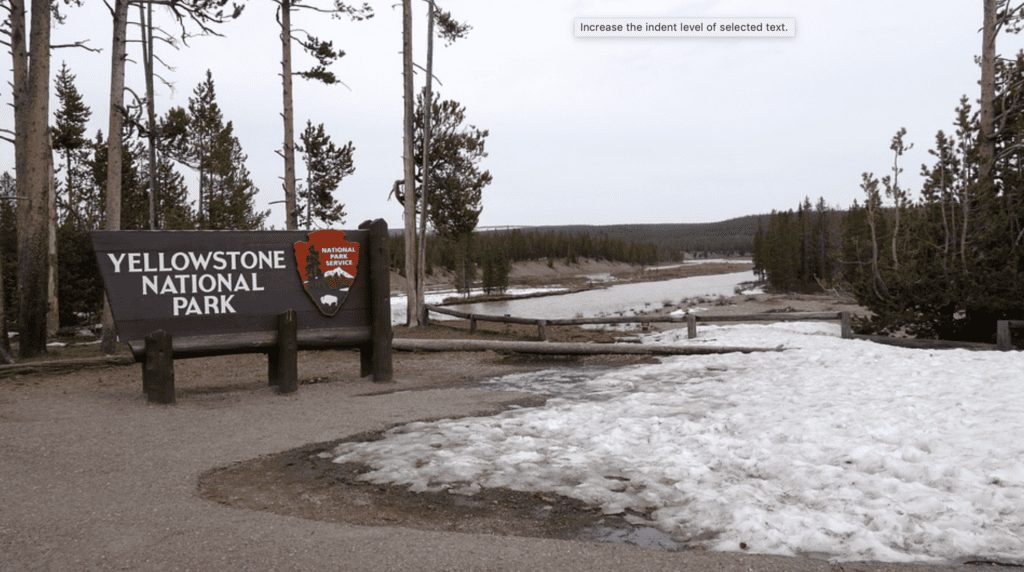
Yellowstone Library and Museum Association was established in 1933 as a forerunner of Yellowstone Forever.
In 1976, Yellowstone National Park received the UNESCO biosphere reserve designation and became a World Heritage Site in 1978. Today, Yellowstone is one of the largest intact temperate zone ecosystems on the earth. It preserves more than 10,000 hydrothermal features.
Yellowstone is also home to the highest density of wildlife in the lower 48 U.S. states. It is the only site in the United States where Bison have lived permanently since prehistoric times!
March 1, 2022, marked the 150th anniversary of Yellowstone National Park. Yellowstone and its supporters will continue to participate in the stewardship of Yellowstone Park for the other 150 years and beyond.
How many Days do you need in Yellowstone?
Spanning three states and 3500 square miles, Yellowstone is a large national park with countless areas and features to explore.
If you are wondering how many days you need to spend in Yellowstone, I recommend at least three full days to see all the main attractions of Yellowstone, including Mammoth Hot Springs, Grand Prismatic Springs, Old Faithful, and many more.
With a three-day Yellowstone itinerary, you have enough time to see a good portion of the park’s highlights and explore them. If you can stay at Yellowstone for four days, you’ll have more time to explore and enjoy the fascinating first US National Park. There is always more to discover at Yellowstone, so if you can, it’s best to stay longer in the park! However, with a three day itinerary, you can see the highlights in Yellowstone.
Make a list of the Yellowstone locations you want to see and check your arrival and departure times to ensure your plan is feasible. Once you have figured it out, you should be able to determine how many days in Yellowstone will be enough.
My three-day Yellowstone itinerary is jam-packed with a lot of activities to do. From alpine peaks to stunning canyons to gushing geysers to gorgeous hot springs, you won’t run out of things to do on your Yellowstone 3-day itinerary!
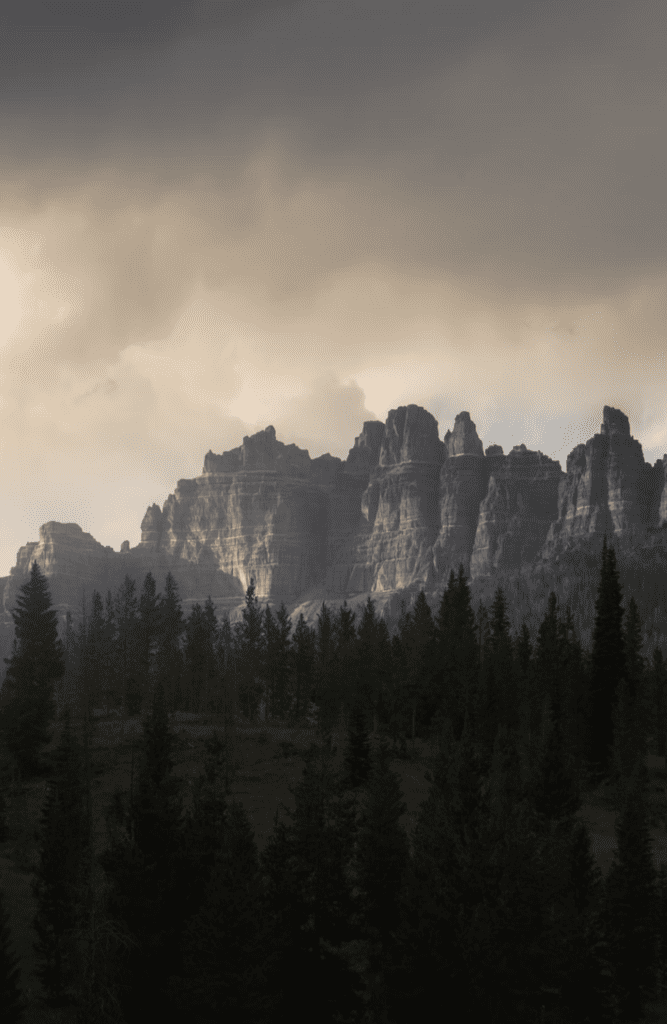
Important Things to Know About Visiting Yellowstone
Millions of tourists flock to Yellowstone annually to create unforgettable memories while watching the roaming wildlife, erupting geysers, and thermophiles’ artistic creations. Before we get to my Yellowstone three-day itinerary, here are several important things to keep in mind, to make your visit successful and enjoyable:
Buy your Entrances Pass online
To get into Yellowstone, you’ll need an entrance pass. By buying your pass online before you go, you can avoid waiting in line at the entrance stations. You can buy a 7-day pass, a Yellowstone Annual Pass, or an America the Beautiful Pass ($80/vehicle for all National Parks). Remember that the summer season is crowded, so be ready for crowds at popular locations and long lineups at the entrance gates, construction zones, and wildlife sightings along the road.
Check Road Statuses
Most Yellowstone roads open in the middle of April and are closed to vehicles in early November. However, weather-related closures may be necessary at any moment. For additional information, visit the Yellowstone roads page. Visit the road construction website to find out about significant road projects and where to anticipate delays and closures due to construction.
Book Ahead of time
Campgrounds and other forms of lodging book up quickly, so reserve Yellowstone hotels early. You should book lodging and campsites 9-12 months in advance.
Save on hotels in Yellowstone with my Expedia discount link:
Allow For Flexibility / Extra Time
Plan ahead and set aside additional time each day to simplify your visit. As you enter Yellowstone’s gorgeous nature, if you find yourself wishing to stay longer in one spot, you’ll be able to if you’ve allowed for flexibility and additional time in your schedule. It’s essential to allow yourself some wiggle room when visiting a park as vast and beautiful as Yellowstone!
Pack for Multiple Seasons – No Matter the Season!
Even in the summer, nighttime lows can be close to freezing, and daytime highs can reach the 80s F. The nearby mountain ranges and high elevation also contribute to the rapid weather changes in Yellowstone, so it’s a good idea to be ready for anything the weather throws at you. Put on a waterproof jacket, rain gear, and a warm insulating layer (like fleece or down) and shed layers as needed.
Wildlife Tips and Safety
You are about to enter a park with wildlife without fences or gates to separate you. Follow safety precautions, maintain the advised distance from animals, don’t turn your back on a wild animal, and capture images from afar. Additionally, it’s smart to have bear spray with you while exploring the park.
My 3-Days Yellowstone itinerary
Now that you’ve been primed on the above, let’s enter Yellowstone National Park!
Here’s my detailed Yellowstone three-day itinerary to help you make the most of your stay.
You can adjust these days if you require a Yellowstone 1-day itinerary or a longer schedule, like a Yellowstone 4- or 5-day plan. On the other hand, my 3-day Yellowstone itinerary aims to give you the best chance to see all the attractions Yellowstone offers in a shorter time period.
Yellowstone Day 1
What is the best way to see Yellowstone in 3 days? Start your Yellowstone three-day itinerary with geysers and hot springs, of course!
On your first day in Yellowstone you will visit:
- Old Faithful, Old Faithful Lodges, Geysers, and Hot Springs
- Grand Prismatic Spring
- Fountain Paint Pots
- Fairy Falls
- Gibbon Falls
- West Thumb Geyser Basin
Old Faithful Geyser Area
You can visit the hot springs geysers on Day 1, including Old Faithful, the well-known geyser. Like Grand Geyser, it is a geyser that frequently erupts, and seeing the geyser erupt is a Yellowstone bucket-list must!
You will see plenty of tour buses in this crowded parking lot because it is a busy area. Old Faithful might erupt soon if a large crowd is present when you arrive (you can also check the Yellowstone app for approximate times.) Using the Yellowstone National Park App, you can find an estimated geyser eruption time. However, you could wait for an hour or longer.
Other geysers in Yellowstone, including Excelsior Geyser and Steamboat Geyser, are unpredictable. The Old Faithful Geyser, however, may be predicted more reliably, at least when compared to an estimated time – hence the name, Old Faithful!
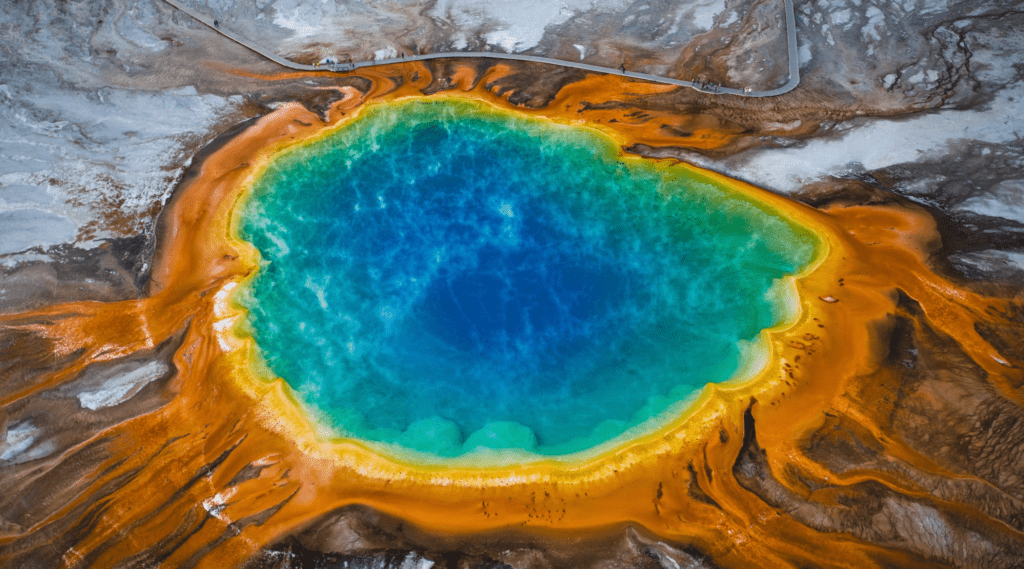
Additional Hot Springs and Geysers
Visit Yellowstone’s Upper Geyser Basin if the Old Faithful geyser isn’t releasing hot water for a spell. Furthermore, the Morning Glory Pool is visible from Old Faithful, which is roughly 1.5 miles away.
Morning Glory is located close to the Black Sand Basin, named due to the obsidian sand. It’s one of the most vibrant parts of Yellowstone.
Midway Geyser Basin
Consider spending this day in the Midway Geyser Basin more thoroughly if you have more than three days to spend in Yellowstone. Excelsior Geyser, Firehole River, and Grand Prismatic Spring are all situated in the Midway Geyser Basin.
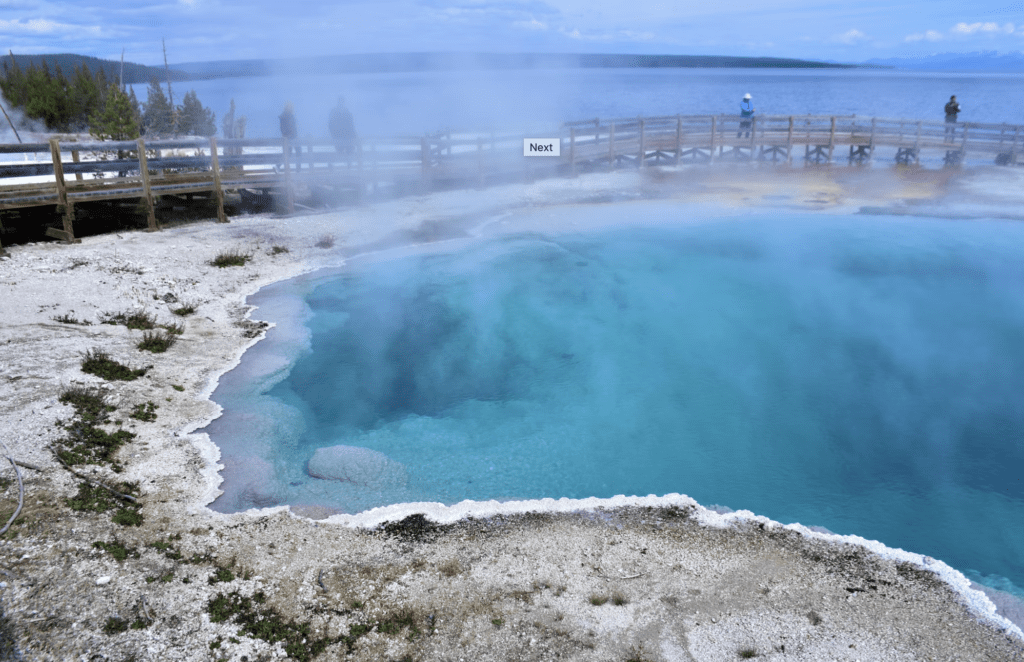
Fairy Falls and Grand Prismatic Spring
Grand Prismatic Overlook is located approximately 6 miles north of the Old Faithful region. You can reach this area from the Fairy Falls Trail.
From here, you can see a stunning view of the Grand Prismatic Spring, one of Yellowstone’s most famous geothermal phenomena. In addition to being the third-largest spring in the world, it is a truly amazing sight because of the rainbow colors that result from bacteria living on it. This attraction is very worthwhile and another Yellowstone must-see!
The Grand Prismatic Overlook’s parking lot is quite small. You can reach the Grand Prismatic Spring Overlook by walking for 0.6–0.8 kilometers from the Fairy Falls parking area, which is about a mile from the Midway Geyser Basin.
Fountain Paint Pots
After that, you can visit Fountain Paint Pots, as well as various boomer rolls, mud holes, and geysers. Visit Fountain Paint Pots, as it displays the active volcano of Yellowstone with bubbling brown, pink, and grey mud pots. But be cautious and stick to the boardwalk, as this is a volatile hydrothermal area.
After visiting this spot, you can travel to Gibbon Falls, a roadside cascade with stunning park views.
Norris Geyser Basin
The Norris Geyser Basin is the oldest and hottest hydrothermal feature in Yellowstone and is also quite active.
The Porcelain Basin is desolate, but there are many sights, sounds, and smells to enjoy. There are also various attractions dotted throughout the wooded Back Basin. Both trails have boardwalks and are .75 miles and 1.5 miles long, respectively.
West Thumb Geyser Basin
The West Thumb Geyser Basin is situated on the bank of Yellowstone Lake. Compared to Fountain Paint Pots and other geyser basins, it is regarded as one of the most picturesque on this side of Yellowstone and somewhat less crowded.
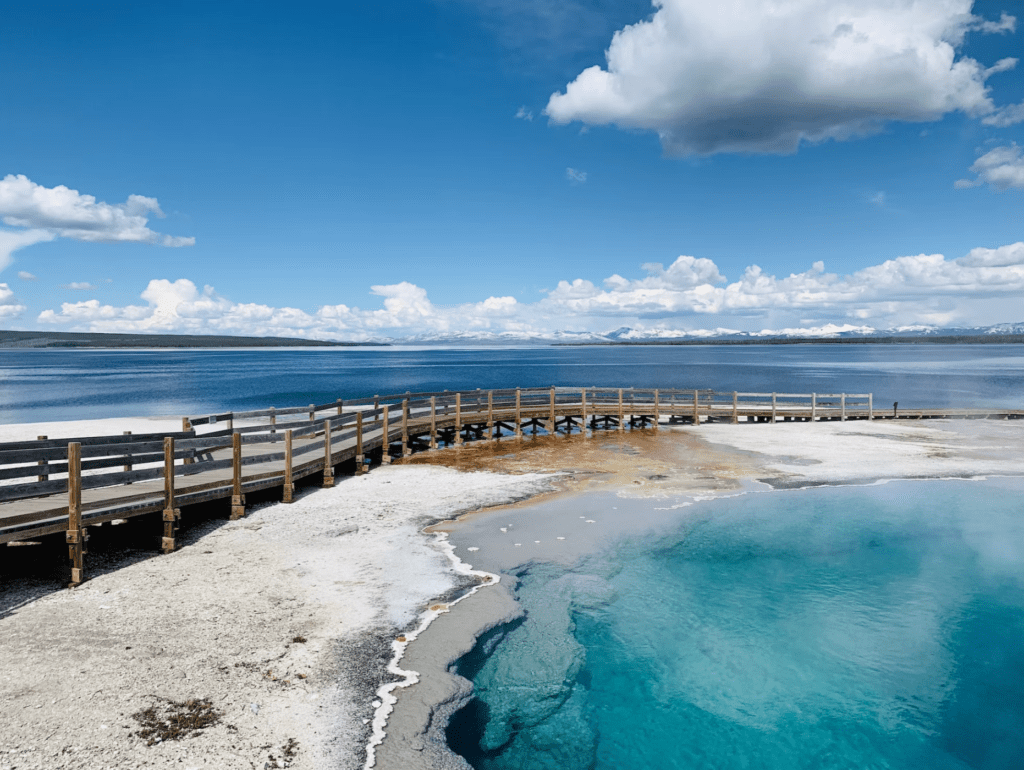
Yellowstone Day 2
Start the second day of your Yellowstone itinerary with early morning wildlife viewing at Lamar Valley. Next, you’ll visit a waterfall, some incredible natural hot springs, and more. Then, wrap it up by gaping at the fascinating Grand Canyon of Yellowstone and take in sunset at Artist Point for an impressive finale to this day!
On Day 2, you’ll visit:
- Lamar Valley
- Undine Falls
- Mammoth Hot Springs
- Tower Roosevelt Area
- The Grand Canyon
- Artist Point
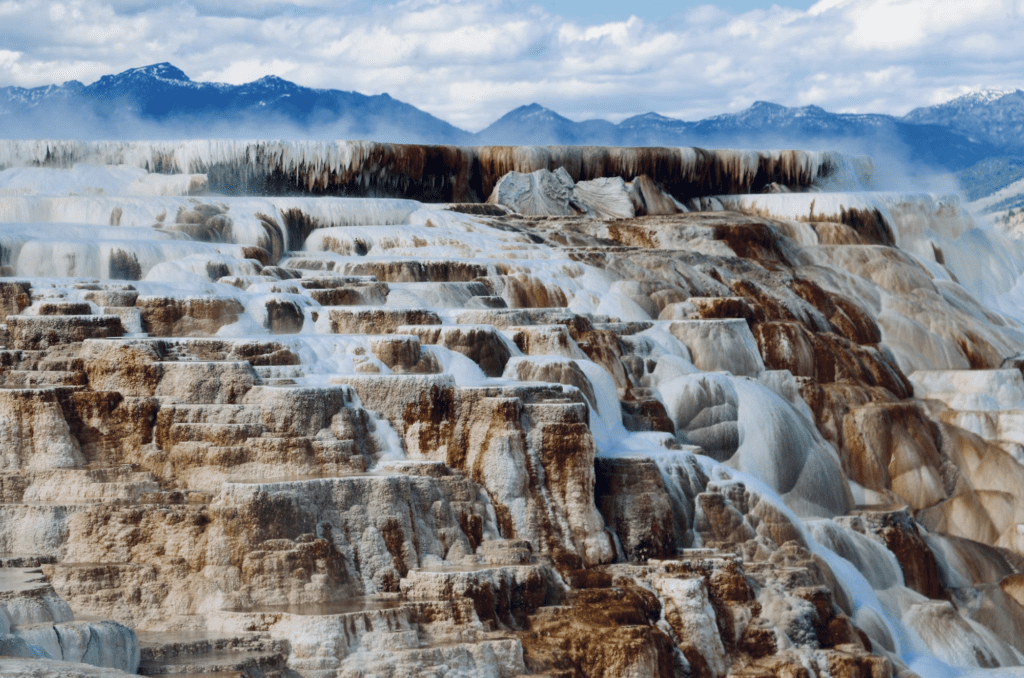
Lamar Valley
Lamar Valley is known as the Serengeti of America! In addition to grizzly bears, osprey, bald eagles, coyotes, and deer, it is common to spot wolf packs and herds of bison in this lovely valley’s wide-open vistas.
But for the best chance of seeing wildlife, you must arrive early or late, as animals are usually active at dawn and dusk in Yellowstone. So head there early in the day!
Drive slowly, and remember not to approach the animals outside your vehicle. Bring your camera (and your patience, in case there is a four-legged traffic bottleneck!)
Undine Falls
Next, you’ll visit Undine Falls, a 60-foot roadside cascade into Lava Creek, on your way to Mammoth Hot Springs, your next stop for today.
If you don’t want to hike the 1.8-mile easy walk out and back, you can still see the Undine falls from the road!
Mammoth Hot Springs
Adding Mammoth Hot Springs to your plan for your three-day Yellowstone itinerary is a must. The Mammoth Hot Springs is a massive network of hot springs where boiling water erupts over limestone terraces.
One of the highlights of Day Two is a visit to the Mammoth Springs and the Fort Yellowstone area of the Mammoth Hot Springs Historic District. The fort comprises 35 buildings from the 1890s to the 1900s. See Boiling River too, if you have time!
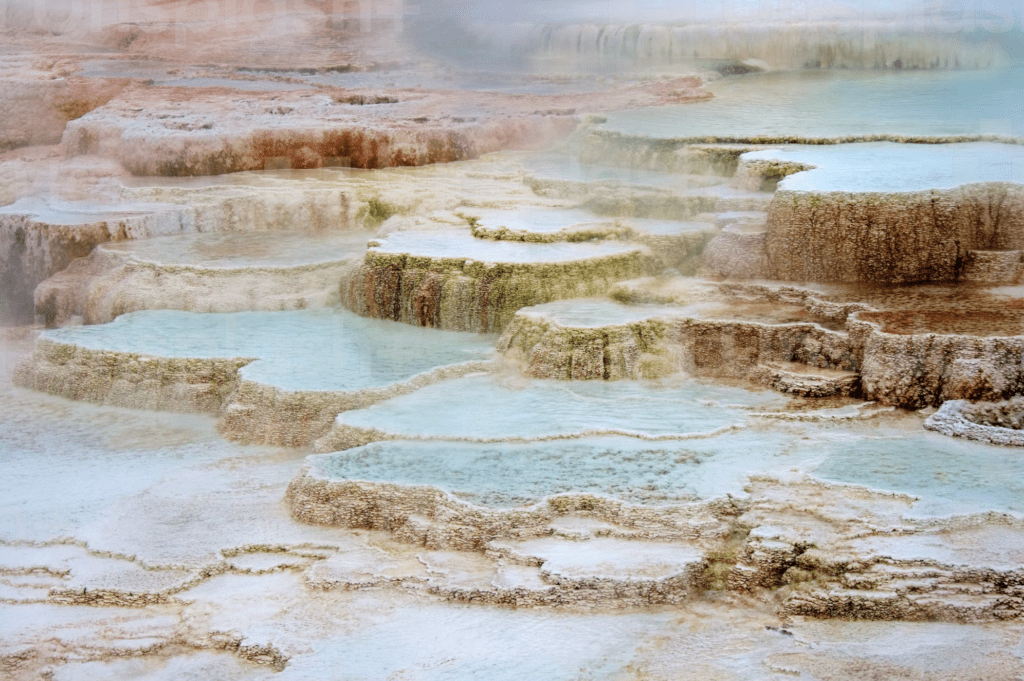
Tower Roosevelt
Tower Roosevelt, a 132-foot cliff surrounded by volcanic pinnacles, is another interesting site. The well-known painting of Tower Roosevelt by artist Thomas Moran was influential in the creation of Yellowstone as a national park in 1872.
The Grand Canyon of Yellowstone
The Yellowstone National Park’s Grand Canyon will be something you must visit on your Yellowstone road trip. This is a fantastic chance to get photographs of this amazing natural phenomenon that the Yellowstone River produced. You can observe the Grand Canyon of Yellowstone from a few treks and vantage points, but make sure to check the app first, as some of the routes might be blocked.
You can make a final stop at Artist Point for sunset, one of the marquees that offer a view of the Yellowstone Grand Canyon. You can see the stunning 308-foot cascade into the Yellowstone River from here.

Save on hotels in Yellowstone with my Expedia discount link:
Yellowstone Day 3
It’s time to explore the south end of Yellowstone National Park on final day during your Yellowstone three-day itinerary!
Today you’ll see:
- Hayden Valley
- Mud Volcano
- Yellowstone Lake
- Hike Storm Point
Hayden Valley
Start Day 3 of your Yellowstone trip by heading south towards Hayden Valley from the Canyon village for some more bison spotting. The benefit of staying in Yellowstone for three days is that you have more time to search for wildlife.
Just keep in mind that in Yellowstone, wildlife takes precedence, so you might need to wait if bison are crossing the road.

Mud Volcano
You’ll also want to stop and see Mud Volcano, one of Yellowstone’s most famous geothermal features.
The trail is only 6 miles long and has boardwalks that cross over the sulfur vents and bubbling mud pots. The swirls of blacks and greys are breathtaking to see. You can enjoy the great views of the Hayden Valley from the Mud Volcano Area.
Hike Storm Point
You can also enjoy a flat 2.1-mile loop hike at Storm Point. As you go east towards Cody, Wyoming, you will explore the trailhead 2.5 miles near the Fishing Bridget Visitor’s Center.
You will initially pass through a meadow of wildflowers in the summer before arriving at a lakeside route with panoramic views.
Yellowstone Lake
Afterward, head to Yellowstone Lake to enjoy boating or picnic there. Fishing, swimming, or going on a kayak tour with a ranger are more activities you may do at Yellowstone Lake.
Yellowstone Lake is situated at 7732 feet above sea level, and the Grand Loop Road extends directly along its shore for a considerable amount of time.
Visit any areas in the lower loop that you might have missed to round up the third day of your Yellowstone three-day itinerary. You could also decide to stay longer and do more exploring at a place you truly like.
You won’t get bored because Yellowstone has so much to offer! Before leaving Yellowstone again, if you have time, stop and view anything you missed at the Lower Loop.
Option Activities and Sights to Add to Your Yellowstone Itinerary:
My 3-day Yellow itinerary is a good time frame to get an excellent overview of Yellowstone National Park. However, you can still add many other activities and sights to your Yellowstone itinerary.
Soak at Boiling River Hot Spring
If you head north, this hot spring is a fantastic addition to your trip! Here you can enjoy swimming at Boiling River Hot Spring, a nearby natural hot spring. In the summer, it attracts a lot of bathers.
Drive through the Beartooth Highway
You can start this scenic drive at Yellowstone’s northeast entrance. A fantastic drive, if you have the time!
Explore Yellowstone Lake by kayak
Kayaking Yellowstone Lake is a great way to see Yellowstone’s geothermal features, and viewing any nearby wildlife!
Go on a few longer hikes
If you have time, hike the majestic Avalanche Peak behind Yellowstone Lake, Trout Lake in the Lamar Valley, and the Point Sublime Trail in the Yellowstone Grand Canyon.
Take a horseback ride
A half-day guided horseback tour, a day trip, or even an overnight backcountry trek on horseback are all wonderful options!
Go rafting in Yellowstone
You can take a white water rafting trip through a section of the Yellowstone River bordering the northern part of the park. Here, the river is ideal for both enjoyable, calm floats, or Yellowstone whitewater rafting trips with plenty of rapids, if you so choose!
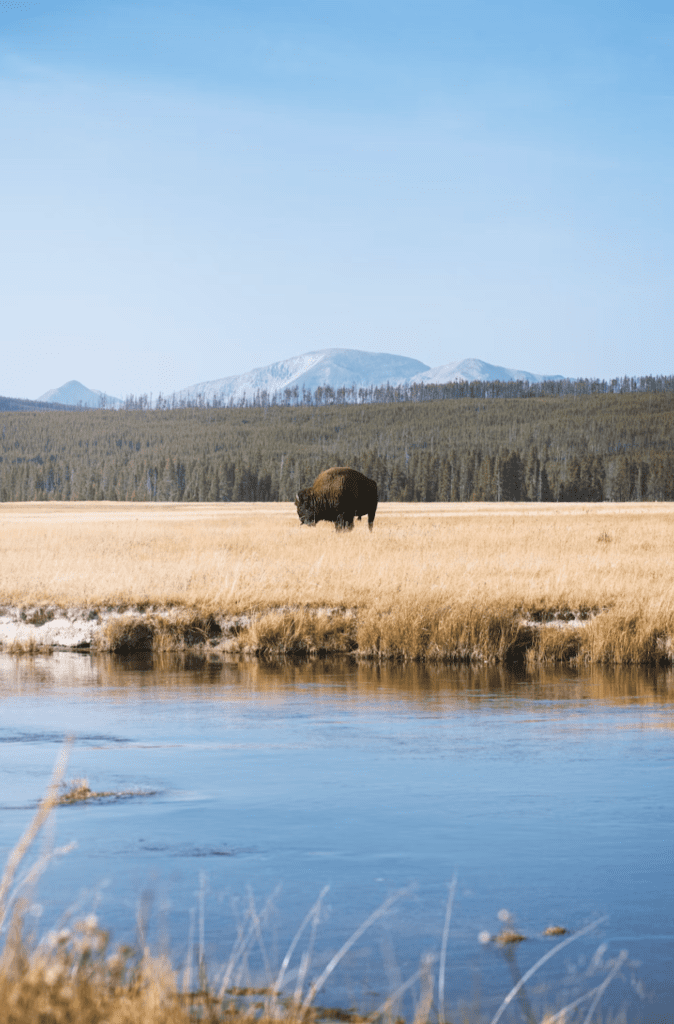
Best Hotels in and around Yellowstone
There are many lodging options in and around Yellowstone National Park, with nine more popular lodgings scattered around inside the park. Choose from these excellent Yellowstone lodging options inside the park based on your interests and budget range!
If you’re looking for luxury resorts in Yellowstone, check out my other blog post:
The BEST Luxury Resorts in Yellowstone National Park
Canyon Lodge and Cabins in Canyon Village

Canyon Lodge is a new accommodation in Yellowstone and has the best location for sightseeing in Yellowstone. It includes five beautiful lodges consisting of 400 guest rooms, including spacious suites for families. The Grand Canyon of Yellowstone is merely a few minutes drive from Canyon village. Furthermore, Hayden valley, Yellowstone Lake, Tower Roosevelt area, Norris Basin, Mammoth Hot Springs, and Lamar Valley are all accessible from Canyon Lodge and Cabins.
The Old Faithful Inn: A National Historic Landmark

Old Faithful Inn is a bucket list stay for your Yellowstone 3-day itinerary, ideally situated next to Old Faithful offering, incredible views of this natural phenomenon!
I recommend reserving this hotel early, because this old hotel fills up quickly, as you might imagine!
This is an excellent spot to stay if you want to do so in a historic building and have the opportunity to see Old Faithful erupt from your room.
Lake Lodge Cabins at Yellowstone Lake

Located right on the lake, Lake Lodge Cabins include the main lodge and 186 cabins, and some cabins even offer gorgeous lake views!
A complete renovation of the Lake Yellowstone Hotel, a National Historic Landmark, took place in 2014. You can also stay at a Lake Cottage – amazing!
Grant Village at Yellowstone Lake
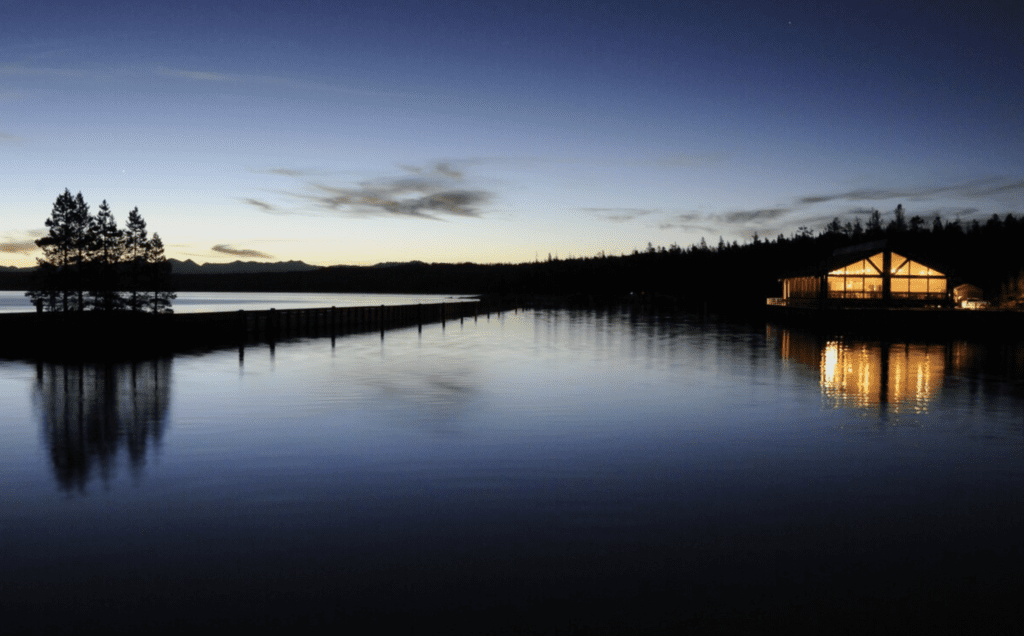
Grant Village lies near the West Thumb Area of Yellowstone Lake. It contains two lodges with 50 rooms and is an incredibly special place to visit during your time at Yellowstone!
Mammoth Hot Springs Hotel and Cabins

This lovely property is located in northern Yellowstone. Mammoth Hot Springs Hotel recently underwent renovations. Enjoy a drink at the club in the Map Room while watching elk graze close to the hotel!
Roosevelt Lodge Cabins

The Roosevelt Lodge Cabins provide rustic cabin accommodations in Yellowstone. An Old West Dinner Cookout is available, and you can enjoy horseback riding nearby at a corral! There is also at least one restaurant in each lodge or community. Many of the larger towns have a number of eateries, convenience stores, and gift shops, like Old Faithful.
West Yellowstone Hotels, Montana
West Yellowstone is located just outside Yellowstone’s West entrance, a mere 10-minute drive from Yellowstone. It offers the best price-quality accommodation at a good site for visiting Yellowstone National Park. It also offers the best restaurants, hotels, short-term rentals, and activities.
Under Canvas Yellowstone:

This isn’t an ordinary hotel; rather, it’s a glamping or luxury camping experience!
Choose from a variety of safari-themed tent designs. Each tent has its own bathroom, some of which may hold up to four people.
Save on hotels in Yellowstone with my Expedia discount link:
What to Pack for a Visit to Yellowstone:
A prepared visitor is a happy visitor, so I recommend packing the following items for your Yellowstone three-day itinerary.
- Phone
- Camera
- Portable Phone charger
- Water bottle
- Snacks
- Binoculars
- Bear spray
- Sturdy Hiking Boots
- Rain Jacket
- Sunscreen
- Sunglasses
- Mosquito Repellent
- Smart Wool Socks
- First Aid Kit
- Warm and cold clothing Layers
- Packing cubes
- Flashlight
Final Thoughts on Yellowstone Three-day Itinerary
Now you have an ultimate Yellowstone three-day itinerary guide to help you to maximize your visit to this cherished National Park! You’ll be able to explore some of the park’s most well-known spots and see a lot of Yellowstone National Park in only a few days, taking amazing photos and making the best memories.
There is plenty to see and do in Yellowstone in just three days, from scenic drives to trekking in the backcountry to see the park’s well-known Old Faithful Geyser and other hydrothermal features to exploring its own Grand Canyon. I hope this 3-day Yelllowstone itinerary guide was helpful for planning your visit to this incredible national park.
It’ll be an epic and memorable outdoor adventure you will love. Hope you have a blast!

You Might Also Like:
The BEST Luxury Resorts in Yellowstone National Park
Travel insurance is incredibly important for any trip to Yellowstone National Park. I highly recommend Safetywing Travel Insurance – learn more about it here:
PIN FOR LATER


![]()
Disclaimer: This blog post may include affiliate links. At absolutely no extra cost to you, I may receive a small commission for any purchase made through these links. Any commissions received are very much appreciated, as they help me to be able to continue posting travel blog content free of charge to my lovely readers. Of course, all recommendations are unbiased, and I will always only recommend products and services that I truly believe in. Thank you for your support!
![]()


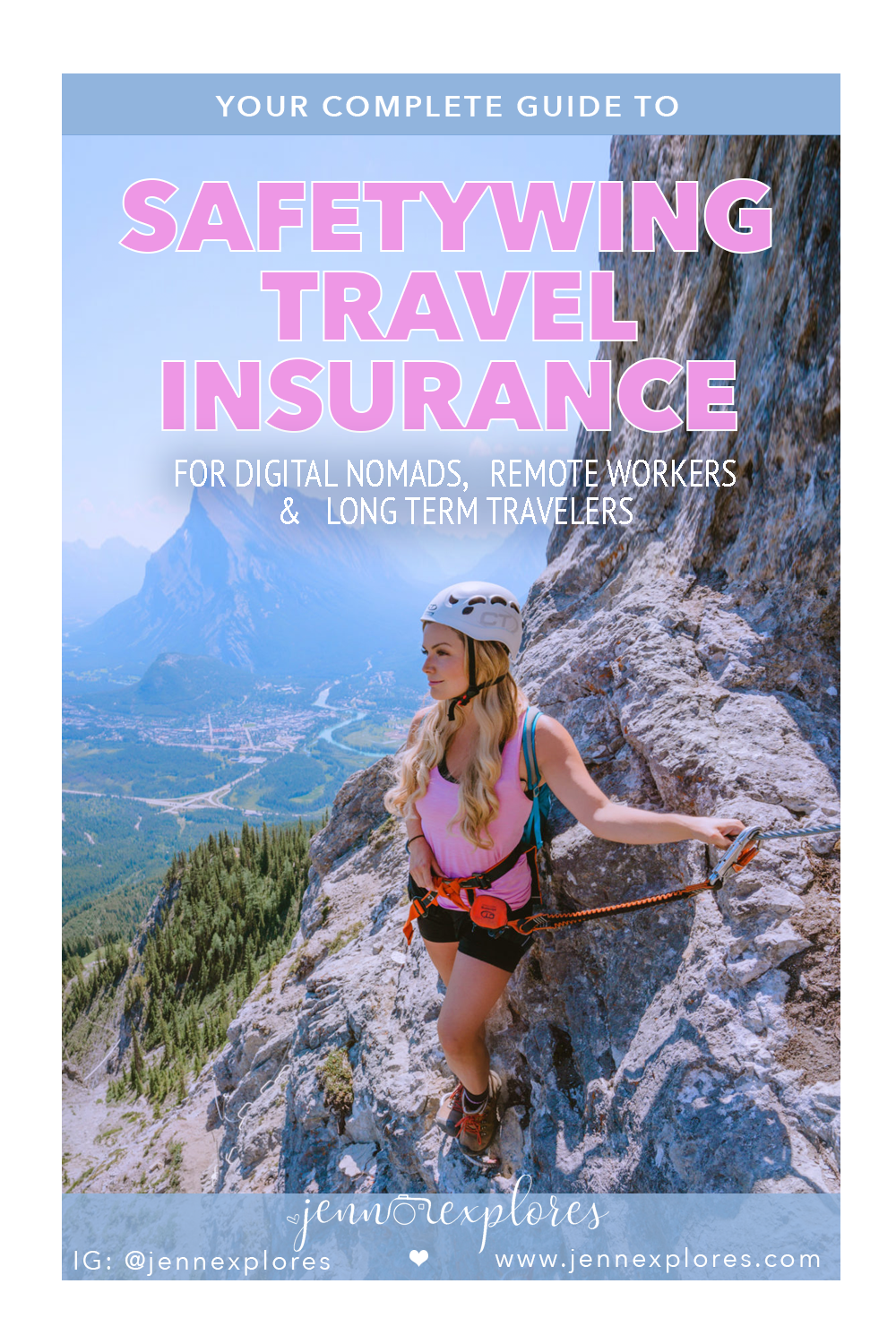

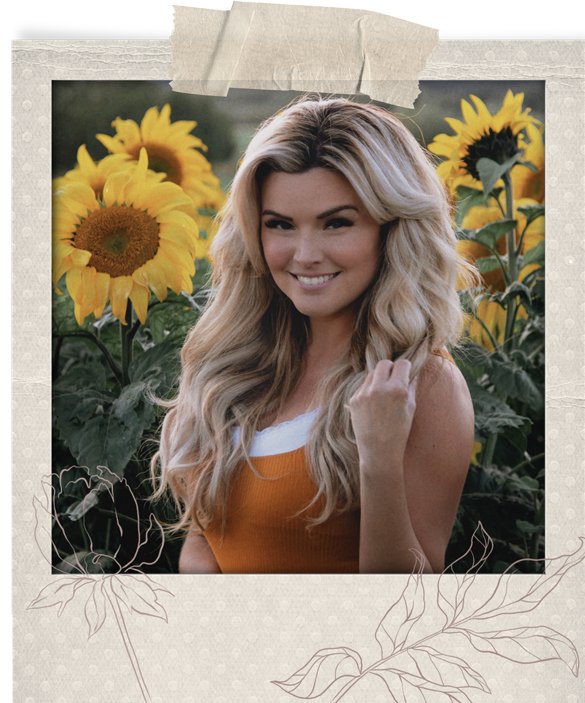





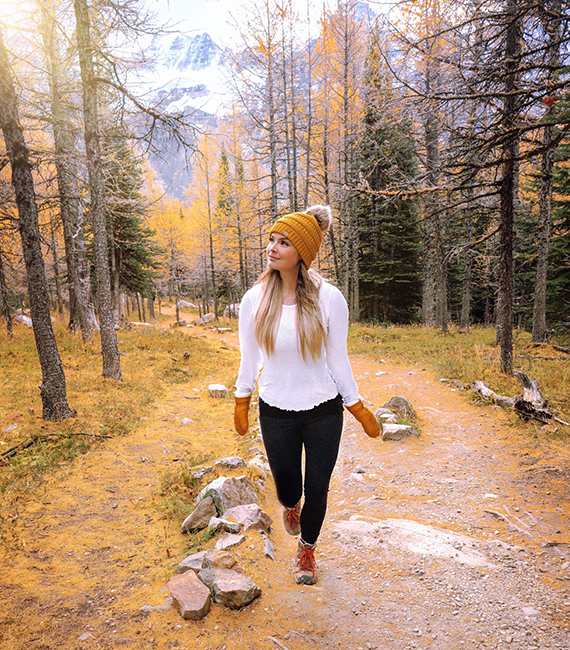


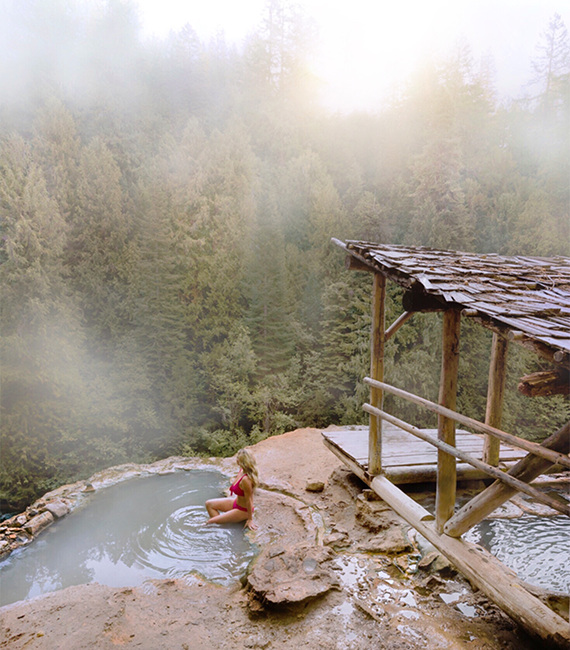
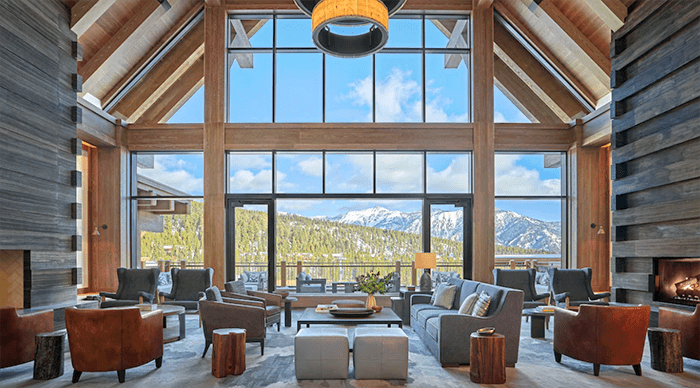
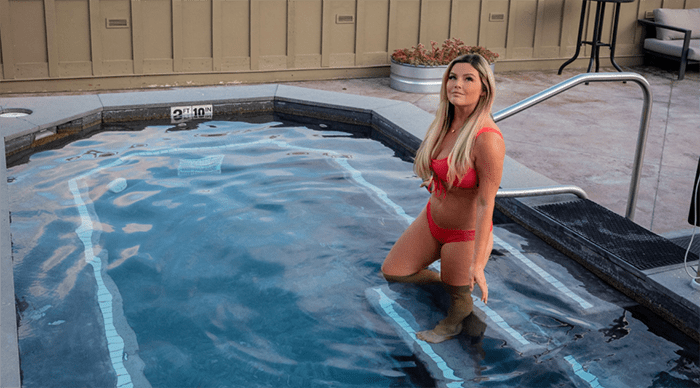



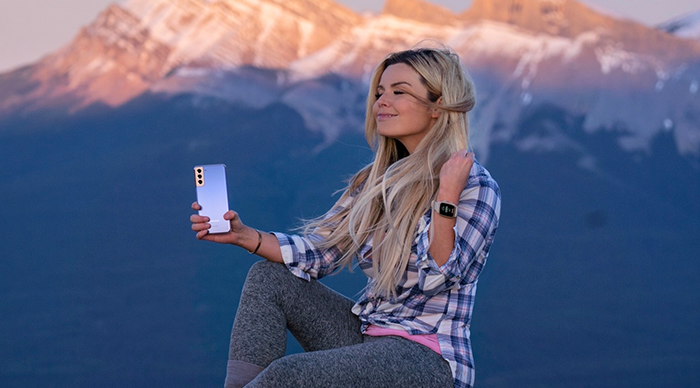
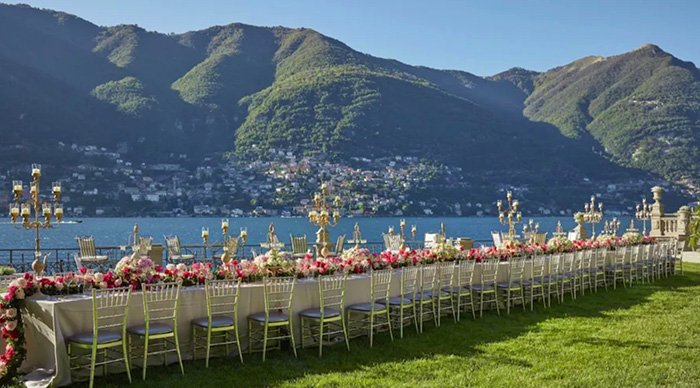

leave me a comment